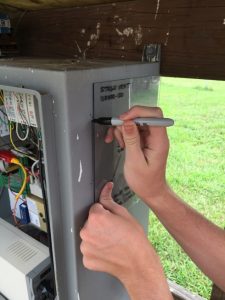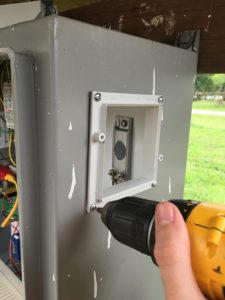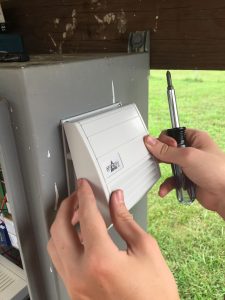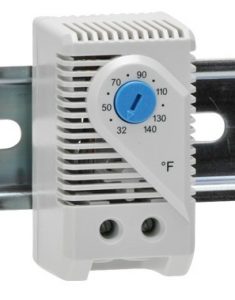RTU Enclosures Can Trap Heat During Summer Months
Jim Mimlitz, NRI
During the summer months, the internal air temperature of outdoor-installed RTU Enclosures can become very hot — especially at locations where the enclosure is subject to direct sunlight. And while the RTU electronics are industrial-rated, and designed to withstand extreme temperatures, the longevity of the equipment can be improved by reducing the extreme air temperatures within the enclosure.
Protection against extreme cold (freezing) and condensation is provided through an internal convection or strip heater. However, the purpose of this article is to address handling the other temperature extreme: HEAT.
There are several available methods to reduce heat inside an RTU enclosure:
- Build a Roof Structure to Shade Against Direct Sunlight
- Installation of an Enclosure Air Conditioning Unit
- Active Ventilation (Forced Air Flow with Electric Fan)
- Passive Ventilation (Free Air Flow)
Option 1, building a roof structure to shade the enclosure, is always a nice option. It also provides the additional benefit of protecting the enclosure against rain/sleet/snow.
Option 2, installation of an enclosure air conditioning unit, is overkill for the typical RTU enclosure. This option is generally reserved for larger VFD enclosures that internally generate a significant amount of heat. The cost of entry-level air conditioning units for industrial enclosures generally exceed $1000 plus installation.
Option 3, active ventilation with a forced air flow fan, is an extremely cost-effective option. The Stego No. 018000-02 is an excellent model for small RTU enclosures. It is available from AutomationDirect.com, and is a shelf-stocked item here at Navionics Research Inc. By default, this unit pulls outside air into the enclosure, although its direction can be easily reversed.
Option 4, passive free-flow ventilation, is the simplest, cost-effective option. The Stego No. 118000-00 is an excellent model for small RTU enclosures. It is also available from AutomationDirect.com, and is also a shelf-stocked item here at Navionics Research Inc.
When providing either active or passive ventilation, it is important to provide a second passive vent in the enclosure to allow for discharge air flow.

Active Fan Ventilation: Stego No. 018000-02

Passive Ventilation: Stego No. 118000-00
Field-Installation of Passive Ventilation Into an RTU Enclosure
At a municipal water district in rural Illinois, the legacy RTU enclosure at the elevated tank was experiencing high internal temperatures, due to direct sunshine on the enclosure outer walls. To provide relief, the water district constructed a roof structure to shield against direct sunlight, and also commissioned the installation of passive ventilation.
The following photos illustrate the finished installation. Please note that any such field-modification may change the NEMA rating of an enclosure. For details, refer to the specifications of the ventilation device and/or the enclosure itself.


Two (2) Stego 118000-00 vents were installed. Note that the vents were installed on opposing sides of the enclosure, and at different elevations, which will foster increased horizontal cross-flow and vertical convective-flow.
The following photos illustrate the installation process for one of the two vents:

Mark Corners For Cutout, and Holes For (Optional) Mounting Screws. A Paper Template Is Provided With The Kit, Although We Have Constructed a PlexiGlass Template For Our In-House Use.

Use Straight Edge To Mark Cutout Boundaries.

Mark Holes For (Optional) Mounting Screws.

Apply Duct Tape To Border To Protect The Enclosure’s Painted Surfaces From Being Scratched During Jigsaw Cutting.

Drill Four (4) Starter Holes For Jigsaw. 3/8 Inch Holes Accommodate Most Standard Jigsaw Blades.

Use A Jigsaw (With Metal-Cutting Blade) To Cut The Square Boundary.

Remove Protective Duct Tape.

Smooth and Deburr the Edges With a Metal File.

Drill Starter Holes For the Four Mounting Sheet Metal Screws (Optional). A 1/8 Inch Bit Was Used.

Clean Out Metal Shavings With Mini Vacuum.

Remove The Protective Paper From the Ventilation Base’s Adhesive Backing.

Attach The Vent Base To The Enclosure Wall, and Secure with Provided Sheet Metal Screws (4).

Attach The Filter Media Holder and Filter. Secure Using Provided Plastic Thread-Rolling Screws. Note that the Filter Media is Fine Enough To Prevent Bugs From Entering, But Coarse Enough To Allow Air Flow.

Attach and Secure The Louvered Vent Cover.

Inside View of the Completed Vent.
Telemetry System historical trends were analyzed before and after the vent installation, and the data validated the successful temperature reduction:
Before Ventilation System Installed
7-24-2016, 5:00pm
Outside Air Temperature: 96.8 degF
Enclosure Inside Air Temperature: 116.9 degF
Inside Minus Outside Temp Differential: +20.1 degF
After Ventilation System Installed
7-27-2016, 4:00pm
Outside Air Temperature: 89.6 degF
Enclosure Inside Air Temperature: 101.8 degF
Inside Minus Outside Temp Differential: 12.2 degF
Without the ventilation, the enclosure temperature had been observed to be around 20 degF higher than ambient. With the ventilation, the enclosure temperature had been observed to be around 12 degF higher than ambient. It would also be expected that active, fan-based ventilation would result in an even lower temperature differential.
RTU Enclosures Installed In Non-Temperature-Controlled Buildings
RTU Enclosures that are installed inside a non-air-conditioned building can also result in extreme temperatures inside industrial enclosures. In these situations, the building can trap heat and become very warm, and the enclosure further traps its internally-generated heat, therefore becoming even hotter than the already-warm building. Furthermore, inside a non-air-conditioned building, there is no air movement to aid in cooling. In these situations, we highly recommend using an electric fan-based vent system, such as the Stego No. 018000-02.
Thermostat-Control of Active Ventilation
When using an electric fan-based ventilation system, logic-control, or thermostat-control is highly recommended. Temperature-based logic or the thermostat will ensure that the fan is only used on an as-needed basis, increasing the longevity of the fan’s moving parts. An example of a cooling thermostat (normally-open, close-on-temp-rise) is the Stego No. 011419-00 din-rail-mount thermostat. It is available from AutomationDirect.com, and is a shelf-stocked item here at Navionics Research Inc.

Stego No. 011419-00 Cooling Thermostat
Winterizing the Ventilation System
During winter months, we recommend closing off the vents, so that energy from the internal enclosure heater is not vented to atmosphere and wasted.
Enclosure Heat Reduction Extends Component Life
Do you have an industrial enclosure that runs too hot in the summer? Passive or active ventilation can extend the life of the internal components by reducing the high temperature extremes. Give us a call, and we’ll get started.
And as always, if you have any questions, please don’t hesitate to reach out by phone or email.
Telemetry, SCADA, & Controls Newsletter
Was this article helpful? Would you be interested in receiving updates such as these in our occasional email-delivered newsletter? If so, here’s our sign-up page:
Subscribe to Navionics Research’s “Telemetry, SCADA, & Controls Newsletter”
